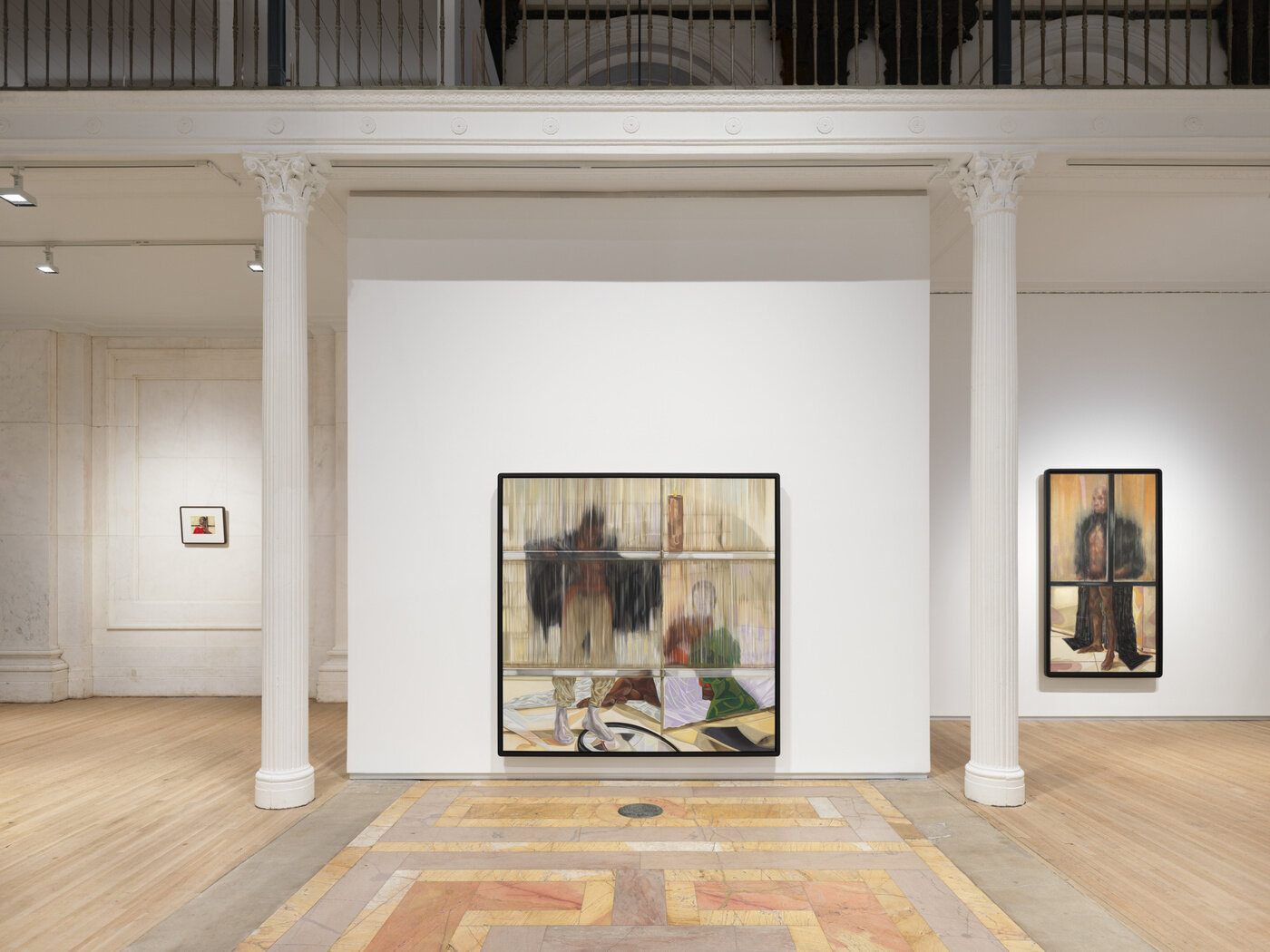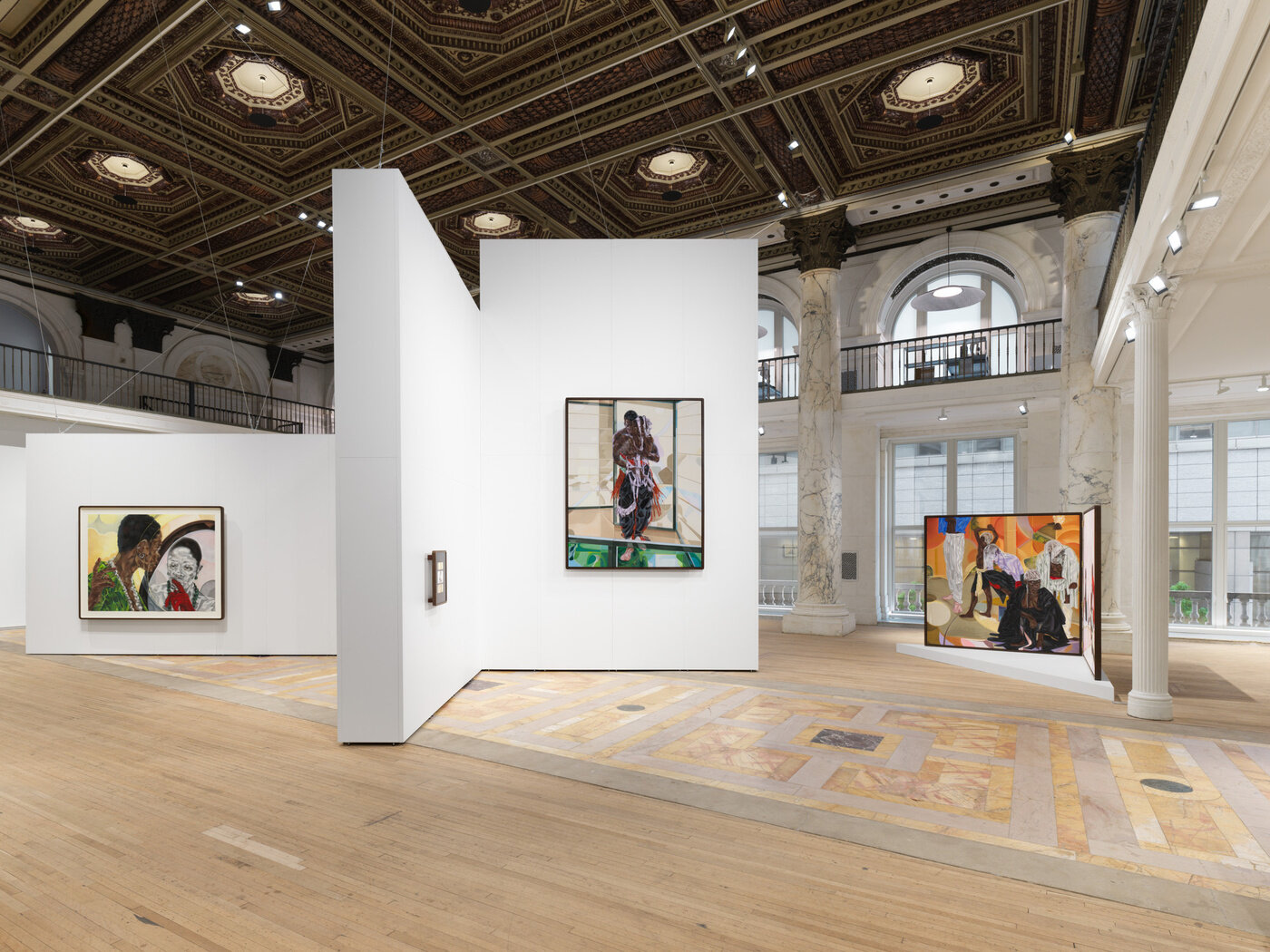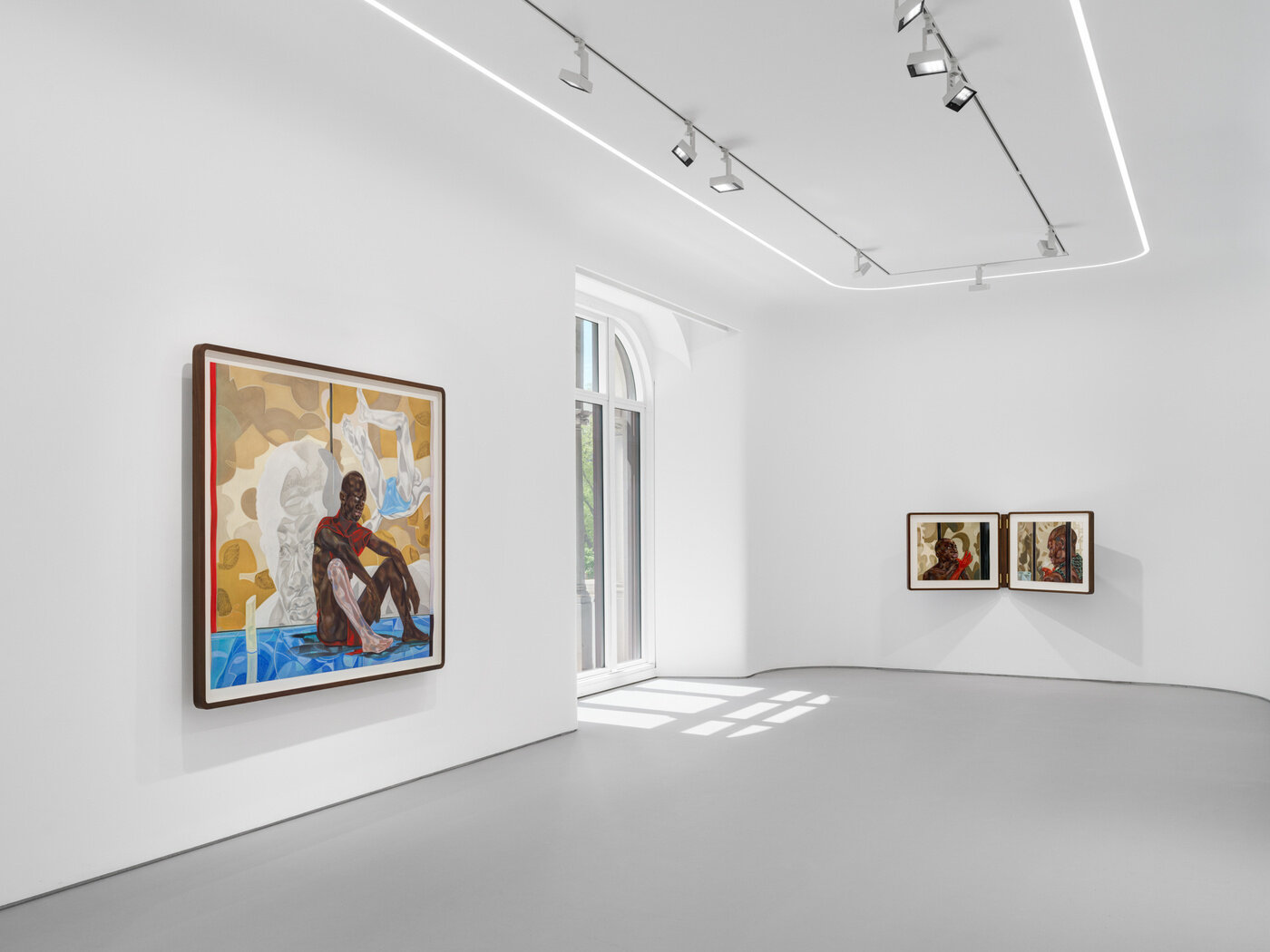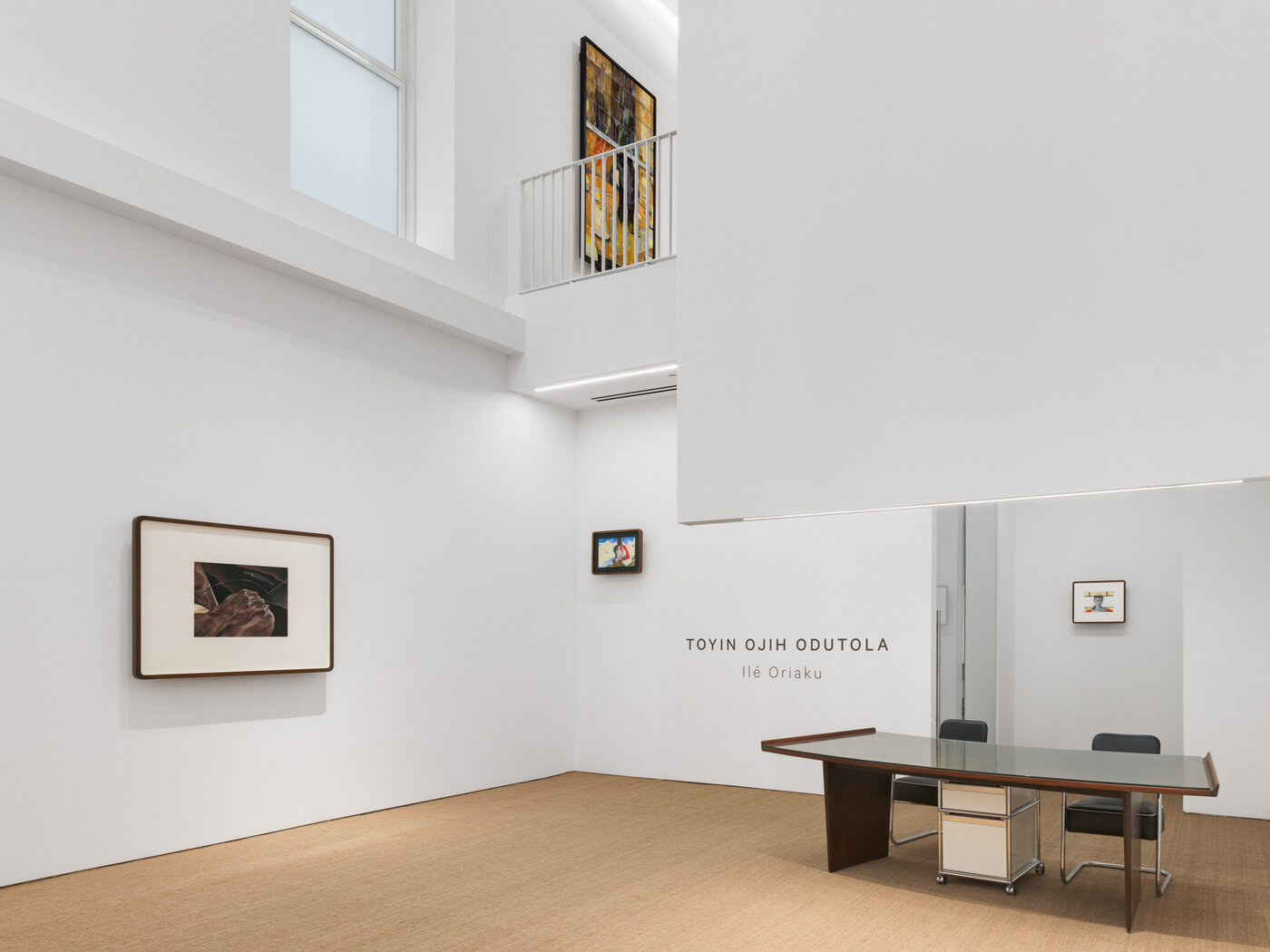Toyin Ojih Odutola: Ilé Oriaku
Works (Tap to zoom)
Press Release
TOYIN OJIH ODUTOLA
Ilé Oriaku
46 Lafayette Street, New York, NY
May 6 – July 18, 2025
Opening reception on Tuesday, May 6th from 6–8PM
PRESS
PRESS RELEASE
Jack Shainman Gallery is pleased to present Ilé Oriaku, an exhibition of multimedia drawings and works on paper by Toyin Ojih Odutola, the artist’s seventh solo show with the gallery. Building upon her inclusion in the Nigerian Pavilion at the Venice Biennale and her solo exhibition at the Kunsthalle Basel, both in 2024, these works present episodic scenes that together explore the uses and limitations of language—including its beauty both in failure and success—as a vehicle for processing grief and as a tool for creating personal meaning and collective history.
The central site that each of these works unfolds in is an imaginary Mbari house, a sacred space rooted in the traditions of the Nigerian Owerri Igbo where members of the community could be celebrated and where deities, those who protect the community from supernatural acts of tragedy and misfortune, could be honored as well. Traditionally crafted from raw materials such as clay, wood and straw, these structures were typically adorned with figures, sculptures, geometric patterns and wall paintings depicting spiritual or mythological themes. The Mbari house that Ojih Odutola has created pays tribute to her late grandmother and uncle who belonged to the Igbo and Yoruba ethnic groups, respectively: ‘Ilé’ means ‘house,’ ‘building,’ or ‘home’ in Yoruba, while ‘Oriaku’ is her grandmother’s Igbo name. So named for her departed family members, this Mbari house functions as a dramatic stage for Ojih Odutola’s figures where they often seem caught in between poses or right before or after an exchange, while also providing a space of spiritual and cultural communion with her ancestors.
Though the Mbari house provides a culturally specific architectural reference, the actual spaces that Ojih Odutola creates from it are often fragmented, blurred and interrupted, such that her figures are rarely depicted free of obstructions. In a similar vein, her subjects regularly obscure their own faces with hands or pieces of clothing, or they appear with their backs turned or in profile. While Ojih Odutola consistently renders what she has called her ‘spiritual performers’ in states of indeterminacy and transition—on the cusp of communication or in its immediate aftermath—she also portrays them in motion and caught between bodily positions. She regularly uses titles that invoke the stage and its spaces of dramatic production, implying a narrative relation between the works while also creating dissonances between what the titles describe and what the drawings show. In spite of the shifts in perspective that happen around these figures, they are still imbued with great psychological presence and specificity, as Ojih Odutola allows them to be read as portraits as much as spiritual ciphers. They ground us in the present while providing a link to the past.
The complex yet sensitive tone that Ojih Odutola achieves throughout the exhibition results in large part from the delicacy of her materials and the precision with which she uses them. For these works she used a variety of materials including charcoal, chalk, colored pencil, graphite and pastel on substrates varying from paper, linen, canvas board and Dura-Lar film. Each work, whether of an intimate or monumental scale, is rendered with luminous color that so often shimmers across the fractured and prismatic architectural spaces. The jewel-like quality of her color palette is rooted in the tradition of Mbari art, where the geographical source of a pigment contributes to its symbolic meaning—for example yellow, symbolizing vitality, was sourced from a sacred site along Nigeria’s Imo River, whereas green, representing renewal, comes from the same river’s clay. Though they carry with them historically specific registers of meaning, the colors Ojih Odutola uses are just as significant for their emotive and descriptive power, or for the way they connect the worlds of her figures to that of our own.
These drawings express Ojih Odutola’s consideration of the ways that language, whether verbal or physical, can act as a barrier to communication just as much as it can facilitate it. Personal and cultural contexts remain crucial for her, specifically with regards to her and her family’s experience of existing between the languages and customs of their native Nigeria and those of the West more broadly. These figures and the scenes they live within are defined by their drive for familial and communal connection, regardless of any obstacle. By doing so they suggest that new languages can still be created.
Coinciding with the exhibition will be the launch of Ilè Oriaku, a new monograph that documents Ojih Odutola’s dual presentations at Kunsthalle Basel and the Nigerian Pavilion during the 2024 Venice Biennale. Designed by Pacific Books and co-published with Kunsthalle Basel, Ilè Oriaku offers a close look at the artist’s richly detailed and illustrative work that captures the nuances of her characters with exceptional precision while also directly examining her Nigerian heritage. Similar to the exhibition at Kunsthalle Basel, the space of the publication evokes an imaginary Mbari house as a grid, taken from the exhibition walls, is abstracted on the printed page to create a conceptual connection to the work and writing within. Scholarly texts by Mohamed Almusibli, Olamiju Fajemisin and Erin Jenoa Gilbert accompany creative contributions from Nelene Ojih Odutola, Toyin Ojih Odutola, Josephine Oriaku Ojih and Lynette Yiadom-Boakye.
About Toyin Ojih Odutola
Toyin Ojih Odutola (b.1985 in Ile-Ife, Nigeria; lives and works in New York, NY) is best known for her multimedia drawings and works on paper, which explore the malleability of identity and the possibilities in visual story-telling. Interested in the topography of skin, Ojih Odutola has a distinctive style of mark-making using only basic drawing materials, such as ballpoint pens, pencils, pastels and charcoal. This signature technique involves the building up of layers on the page, through blending and shading with the highest level of detail, creating compositions that reinvent and reinterpret the traditions of portraiture. Ojih Odutola credits the development of her style from using pen, which holds a special significance through its function as a writing tool, as her work is also akin to fiction. She often spends months crafting narratives that unfold through series of artworks like the chapters of a book.
Her work is inspired by both art history and popular culture, as well as her own personal history—being born in Nigeria then moving as a child to America where she was raised in conservative Alabama. The idea of traveling or transporting the self is a recurring theme in her work and for Ojih Odutola, the construction of her figures is a means of discovering an individual’s character and personal story. Though the representation of skin has been a core focus of her practice, she has also explored depictions of landscapes, architecture and domestic interiors in more recent series.




